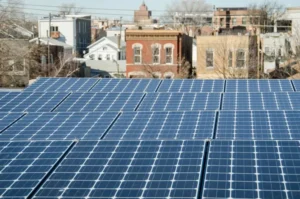So, the Sun Isn’t Always Shining. We Planned for That.
Let’s talk about reality.
The reality of living in Illinois is that some days are a brilliant, perfect blue. And many, many days are the color of a wet sidewalk.
So when someone starts talking about a “personal power plant on your roof,” your first thought isn’t about the sunny days. It’s about the cloudy ones. It’s about November. It’s about that week in February when you forget what the sun even looks like.
If your power comes from the sun, what happens when the sun takes a vacation for half the year? Do your savings get cut in half? Do you have to start paying the utility again every winter?
It’s the most logical question in the world.
And the answer is what elevates solar from a “nice idea” to a rock-solid financial strategy.
Your Roof Works Like a Squirrel
Think about a squirrel in August.
He isn’t just eating for today. He’s frantically gathering and burying nuts, storing up a surplus for the lean months ahead. He’s using the season of abundance to prepare for the season of scarcity. It’s the smartest, most natural strategy in the world.
Your solar system is designed with the exact same logic.
On those long, bright summer days, your panels will often generate far more electricity than your home is using. You’re harvesting a huge surplus of clean energy.
But that power doesn’t just vanish. It flows out from your home and onto the grid. Your utility, ComEd, is required by Illinois law to act as your bank. They measure every single watt you contribute and credit it to your account.
You are essentially spending the summer making massive deposits into your energy savings account.
The Surprising Power of a Gray Day
It’s an understandable reflex. You see a thick cloud roll in, blocking the sun, and you think, “Well, there goes my power production.”
But your solar panels don’t see an “off” switch. They just see a dimmer switch.
Think of it this way: Your panels generate electricity from photons—particles of light. On a bright, cloudless day, your roof is getting hit with a firehose of photons. On a cloudy day, it’s not a dry pipe. It’s a steady trickle.
And a trickle, flowing consistently over hours, still fills a bucket.
This isn’t an accident. Modern solar panels are marvels of engineering, specifically designed to be hyper-efficient at capturing a wide spectrum of light, not just direct, blistering sun. In fact, some panels perform even better in cooler temperatures.
Many of the systems we design at Windfree use what are called bifacial panels. These are the overachievers of the solar world. They don’t just capture light from above; they capture ambient and reflected light from your roof surface and the clouds themselves. They are literally built to squeeze every last drop of power out of an imperfect Illinois day.
So you have two elegant systems working in perfect harmony.
- The Technology: Panels that work surprisingly hard on gray days, constantly adding to your total.
- The System: The Net Metering “energy bank” that uses summer’s abundance to make winter’s scarcity a non-issue.
It’s a belt-and-suspenders approach to energy freedom. The panels handle the day; the system handles the year.
The question isn’t whether solar works in Chicago. The question is why nobody told you how cleverly it was designed for it.
Then, when November rolls around and the skies turn gray, you simply start making withdrawals. On a cloudy day, or in the middle of the night, when your panels aren’t producing, your home automatically draws power from the grid, just like it always has. But instead of paying for it, you’re simply drawing against the massive surplus you built up all summer.
This elegant system has a name: Net Metering.
It means we don’t have to worry about a few cloudy days. It means we don’t fear the Chicago winter. The system was designed for it. It’s not about generating all your power every single day; it’s about generating a net surplus over the course of the year.
You use the abundance of summer to make the scarcity of winter irrelevant.
The biggest myth about solar in Illinois is just that: a myth.
The system isn’t broken on cloudy days. The winter isn’t a fatal flaw. It’s all part of the plan. It’s not a bug; it’s a feature.
The elegant design of Net Metering acts as your energy bank, and the surprising efficiency of modern panels acts as your constant depositor. One handles the seasons, the other handles the day. Together, they make your energy independence a year-round reality.
But a blog post can only show you the blueprint. It can’t show you the view from your own roof. It can’t account for the morning shade from your maple tree or the wide-open sun your garage gets all afternoon.
The gray skies aren’t a barrier. They’re just a variable in an equation.
And we can solve that equation for your specific home in about 15 minutes.




